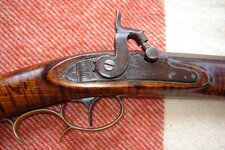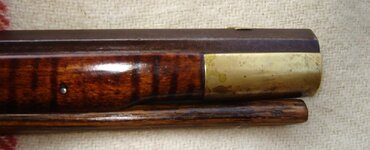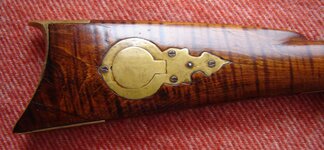Staff Member
Gold Supporter
Bronze Lifetime
- Messages
- 23,249
- Reactions
- 111,399
So I posted this pictures of this rifle before...just thought that I would add more detail to the description.

Henry Leman Trade Rifle Circa late 1830's.
.50 caliber percussion full stock rifle.
1-60 twist , 42 inch barrel , maple stock , single trigger and a cap box.
Henry Leman made rifles from 1834 -1887 Leman's factory was in Lancaster Pennsylvania.
A note or two about Trade Rifles and Leman rifles...
A Trade Rifle was a rifle made to be used / sold or traded in the fur trade.
These rifles were used as personal rifles by fur traders and trappers as well as being traded to the tribes for furs , hides , horses etc...
Many companies made Trade Rifles J.Henry , Dickert , Fordney , Derringer and many others as well as Leman.
Henry Leman was a prolific rifle maker....But...
He had a factory...so lots of folks actually made Leman rifles...one guy was a stock maker...another guy worked on assembling the locks...someone else made barrels...etc..
It was a true assembly line process.
Also Leman sold parts such as locks and barrels....so just 'cause a rifle has a Leman marked lock or barrel...does not mean that the rifle is a Leman rifle...you gotta look at the whole rifle and see if it fits in with a actual Leman rifle's style.
Leman made two basic Trade Rifles...one with a full stock and one with a half stock.
Both have some basic forms that make for a distinctive Leman look.

The Ashmore lock..
Originally a flintlock , this lock was converted to percussion...if one look close you can see the brass pins in the screw holes , where the frizzen spring was located.
I think that this lock was converted to percussion , then fitted to this rifle...I do not think that the rifle was a flintlock.
Ashmore was a English Gunmaker from 1827 - 1855...many American rifles used imported English locks.


The rear and front sights.
18th and 19th century rifle had low sights....much lower than the sights commonly seen on today's replicas , recreations and reproduction rifles.
Why...?
I do not know for sure...
Lots of armchair reasons out there...such as low sights won't snag on brush etc.....
I think it was just style...as in firearm styling and shooting style.
The low sights are quick to align and make for "easy" snap shooting...they do however suffer from "heat mirage"
( becoming blurry) with extended shooting.

The capbox...used to hold percussion caps or shooting patches.
These come in many styles...the one seen here is very typical of a Leman rifle.
Also note the stripe pattern....its very pretty.
Just like today...folks in the 19th century like a good looking rifle.
Leman knew this and often artificially stripped his rifle stocks....this one is done with stain applied to the stock to simulate natural curl , before the actual finish was done.
Some folks say that he heated a thin metal rod and scorched his stocks....I have never seen a Leman rifle stock that was made that way.
Well I hope y'all enjoyed a little more detailed look at this rifle and that I didn't bore ya too much.
Andy

Henry Leman Trade Rifle Circa late 1830's.
.50 caliber percussion full stock rifle.
1-60 twist , 42 inch barrel , maple stock , single trigger and a cap box.
Henry Leman made rifles from 1834 -1887 Leman's factory was in Lancaster Pennsylvania.
A note or two about Trade Rifles and Leman rifles...
A Trade Rifle was a rifle made to be used / sold or traded in the fur trade.
These rifles were used as personal rifles by fur traders and trappers as well as being traded to the tribes for furs , hides , horses etc...
Many companies made Trade Rifles J.Henry , Dickert , Fordney , Derringer and many others as well as Leman.
Henry Leman was a prolific rifle maker....But...
He had a factory...so lots of folks actually made Leman rifles...one guy was a stock maker...another guy worked on assembling the locks...someone else made barrels...etc..
It was a true assembly line process.
Also Leman sold parts such as locks and barrels....so just 'cause a rifle has a Leman marked lock or barrel...does not mean that the rifle is a Leman rifle...you gotta look at the whole rifle and see if it fits in with a actual Leman rifle's style.
Leman made two basic Trade Rifles...one with a full stock and one with a half stock.
Both have some basic forms that make for a distinctive Leman look.

The Ashmore lock..
Originally a flintlock , this lock was converted to percussion...if one look close you can see the brass pins in the screw holes , where the frizzen spring was located.
I think that this lock was converted to percussion , then fitted to this rifle...I do not think that the rifle was a flintlock.
Ashmore was a English Gunmaker from 1827 - 1855...many American rifles used imported English locks.


The rear and front sights.
18th and 19th century rifle had low sights....much lower than the sights commonly seen on today's replicas , recreations and reproduction rifles.
Why...?
I do not know for sure...
Lots of armchair reasons out there...such as low sights won't snag on brush etc.....
I think it was just style...as in firearm styling and shooting style.
The low sights are quick to align and make for "easy" snap shooting...they do however suffer from "heat mirage"
( becoming blurry) with extended shooting.

The capbox...used to hold percussion caps or shooting patches.
These come in many styles...the one seen here is very typical of a Leman rifle.
Also note the stripe pattern....its very pretty.
Just like today...folks in the 19th century like a good looking rifle.
Leman knew this and often artificially stripped his rifle stocks....this one is done with stain applied to the stock to simulate natural curl , before the actual finish was done.
Some folks say that he heated a thin metal rod and scorched his stocks....I have never seen a Leman rifle stock that was made that way.
Well I hope y'all enjoyed a little more detailed look at this rifle and that I didn't bore ya too much.
Andy











